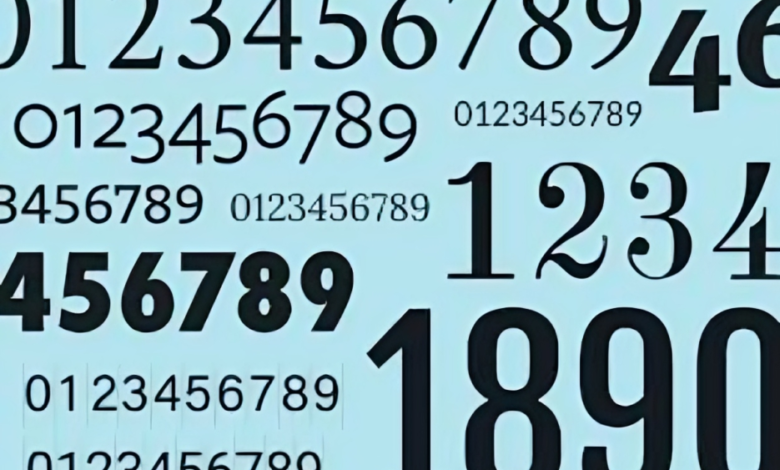The Ultimate Guide to Number Fonts Enhance Your Typography Game

In the world of typography, numbers often take a backseat to letters. However, the right number font can elevate your design, making it more readable and visually appealing. Whether you’re designing a logo, creating an infographic, or working on a website, understanding number fonts and their impact is essential. In this article, we’ll explore the different types of number fonts, their uses, and tips for selecting the perfect one for your project.
What Are Number Fonts?
Number fonts are typefaces specifically designed to represent numerical characters. While many fonts include numbers, certain typefaces emphasize numerals’ style and legibility. These fonts cater to various design needs, ranging from formal to casual and minimalist to ornate.
Importance of Number Fonts
- Clarity: Numbers need to be easily read, especially in contexts like data visualization, finance, or education. The right font can enhance clarity and comprehension.
- Brand Identity: The font you choose can reflect your brand’s personality. A tech company might opt for a sleek, modern font, while a vintage shop might go for something more decorative.
- Aesthetic Appeal: A well-chosen number font can add visual interest to your designs, creating a cohesive look that draws attention.
Types of Number Fonts
Number fonts can be categorized into several types based on their style and intended use. Here are some popular categories:
1. Serif Fonts
Serif fonts are characterized by small lines or decorative strokes at the ends of their letters. When it comes to numbers, serif fonts often convey a sense of tradition and reliability. Common uses include formal documents, printed materials, and branding.
Examples: Times New Roman, Garamond, and Georgia.
2. Sans Serif Fonts
Sans serif fonts lack the decorative elements found in serif fonts, providing a cleaner, more modern appearance. They are often used for digital applications, as they are easier to read on screens.
Examples: Arial, Helvetica, and Futura.
3. Slab Serif Fonts
Slab serif fonts have thick, block-like serifs, giving them a bold and sturdy look. These fonts are excellent for headlines or any design requiring impact.
Examples: Rockwell, Museo Slab, and Clarendon.
4. Display Fonts
Display fonts are unique and artistic, often used for headlines or logos. They can vary widely in style, and some may have exaggerated or unusual numeral designs.
Examples: Bebas Neue, Impact, and Playfair Display.
5. Monospaced Fonts
Monospaced fonts feature characters that occupy the same amount of horizontal space, making them ideal for programming and data presentation. This uniformity aids in readability, particularly in tables or code snippets.
Examples: Courier New, Consolas, and Menlo.
Choosing the Right Number Font
Selecting the right number font can be a challenging task, but considering the following factors can simplify the process:
1. Purpose of the Design
Identify the primary function of your design. Are you creating a formal document, an engaging infographic, or a fun flyer? The purpose will guide your font choice.
2. Legibility
Ensure that the numbers are easily readable at various sizes. Test the font in different contexts to confirm its clarity.
3. Branding
If you’re designing for a brand, consider its identity and how the font aligns with it. A font that reflects the brand’s values will resonate better with the target audience.
4. Contrast and Color
Think about how the font will interact with colors and other design elements. High contrast between the font and background improves readability.
5. Style Consistency
Maintain consistency with other typography in your design. The number font should complement the letter fonts used in the project.
Popular Number Fonts and Their Applications
Here are some standout number fonts and the contexts in which they shine:
1. Bebas Neue
Bebas Neue is a bold, sans-serif font that’s perfect for headlines. Its clear and straightforward numbers work well in posters, advertisements, and branding.
2. Montserrat
This modern sans-serif font is highly legible and versatile. It’s suitable for websites, presentations, and print materials. The numbers in Montserrat are clean, making them an excellent choice for digital interfaces.
3. Roboto
Roboto combines geometric shapes with friendly curves. It’s particularly popular in web design and app development. The numbers are designed to be easily readable on screens, making it a favorite for tech companies.
4. Georgia
A classic serif font, Georgia’s numbers add a touch of elegance to any design. It’s ideal for printed materials, including books, magazines, and reports.
5. DIN
DIN is a sans-serif typeface known for its clean lines and industrial feel. Its numbers are crisp and straightforward, making it perfect for signage, labels, and technical documentation.
Tips for Using Number Fonts Effectively
1. Hierarchy and Size
Establish a clear hierarchy by varying the size and weight of your numbers. Use larger, bolder fonts for key figures and smaller sizes for supporting information.
2. Spacing and Alignment
Proper spacing between numbers enhances readability. Pay attention to alignment, especially in tables or lists, to maintain a clean and organized appearance.
3. Experiment with Styles
Don’t hesitate to experiment with different styles and weights of the same font. Mixing regular and bold versions can create visual interest while maintaining consistency.
4. Test Across Platforms
Fonts may render differently across various devices and platforms. Always test your designs on multiple screens to ensure they look good everywhere.
5. Stay Updated with Trends
Typography trends evolve, so keep an eye on what’s current in the design world. Fresh ideas can inspire new ways to incorporate number fonts into your work.
Conclusion
Number fonts play a crucial role in effective design, yet they are often overlooked. By understanding the various types of number fonts and how to choose the right one, you can enhance the clarity and aesthetic appeal of your projects. Whether you’re designing for print or digital media, the right number font can make all the difference. So, the next time you sit down to design, remember the power of numbers and choose your fonts wisely. Happy designing!




